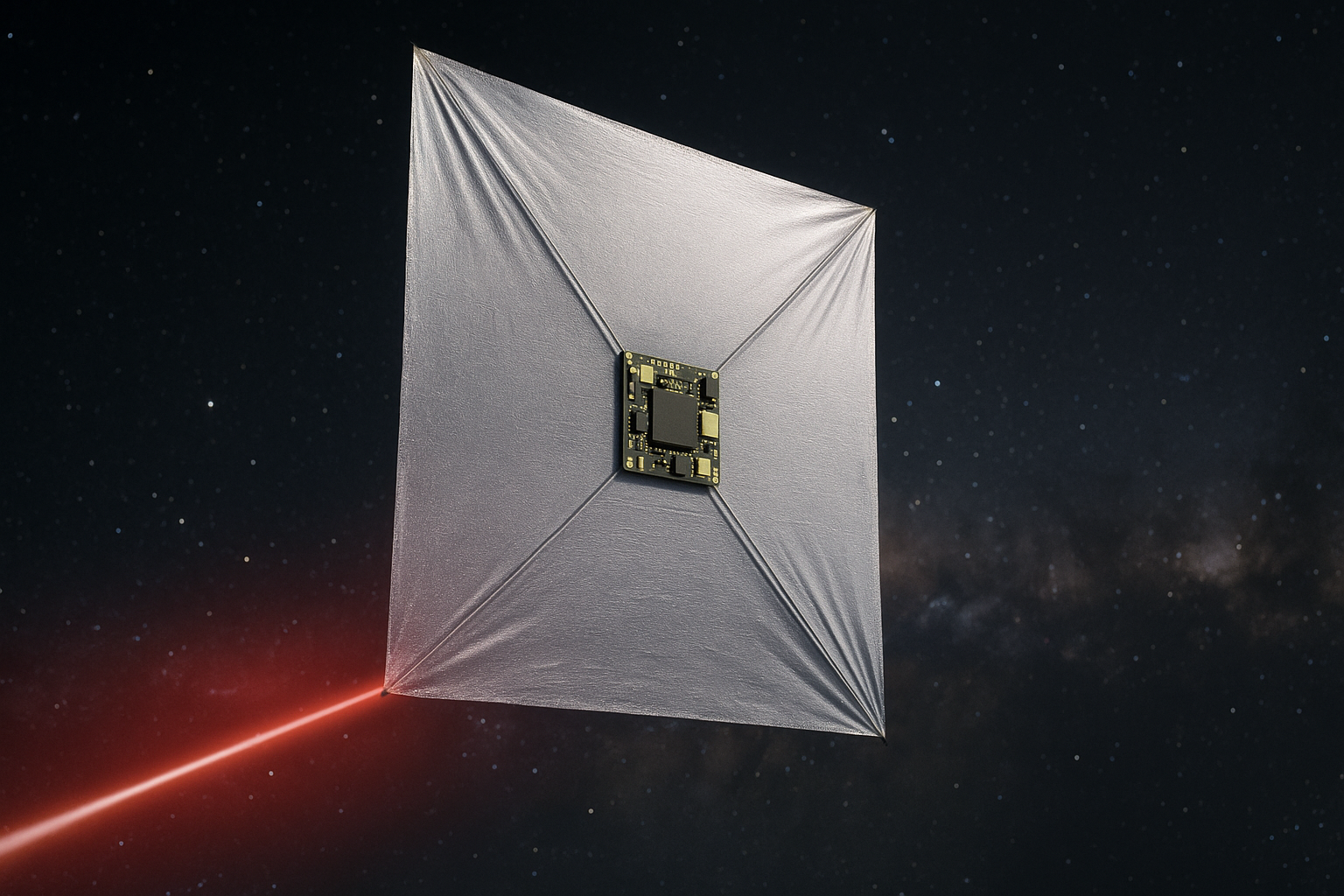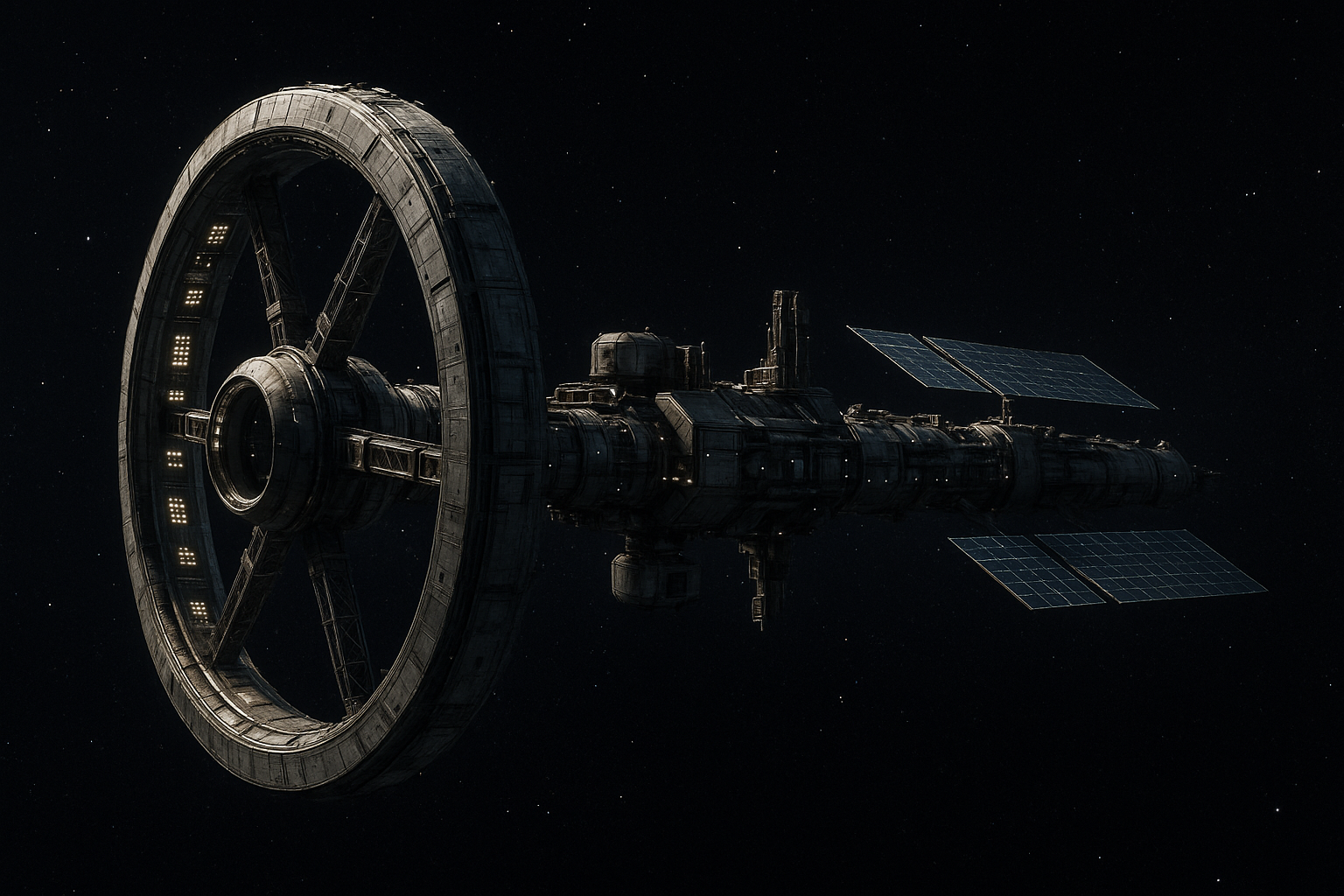- Published on
Alpha Centauri or Bust: Our First Interstellar Mission
- Authors

- Name
- Tony Geiser
Alpha Centauri or Bust: Humanity's First Starship
We humans love impossible challenges, especially when they involve strapping lasers to tiny space-chips!

Alpha Centauri, our nearest stellar neighbor at a "mere" 4.37 light-years away, tempts us with promises of habitable planets and maybe even some alien drama. Ever since astronomers found Proxima b, a potentially Earth-like world orbiting Proxima Centauri, we've been itching to send probes, postcards, and probably some unsolicited advertisements.
Besides, if we're going to prove humanity's interstellar cred, we need to pick the low-hanging stellar fruit.
But let's get real: reaching Alpha Centauri isn't like driving to Grandma's house.
With current technology, even our fastest rockets would take tens of thousands of years, making "are we there yet?" jokes lose their charm. Forget about packing snacks; we'd need multi-generational ships or propulsion systems lifted straight from sci-fi to make this feasible.
It's like the Oregon Trail, except dysentery is replaced by cosmic radiation.
So, the solution is simple (in theory): just go faster, much, much faster.

Enter laser sails and nanocraft, tiny ships no heavier than your car keys, propelled by a super-powered laser beam from Earth. This isn't some science-fiction fever dream; Breakthrough Starshot, backed by billionaire Yuri Milner and Stephen Hawking, aims to send tiny, chip-sized spacecraft zipping to Alpha Centauri at 20% the speed of light.
At these speeds, humanity's first interstellar selfie could be snapped within our lifetimes, though your hair might be considerably grayer by then.
Sounds simple, right?
Not quite.
Engineering reality can be a buzzkill, especially when your spacecraft faces dust particles that behave like relativistic bullets. A single speck at these velocities could obliterate your starship faster than you can say "oops."
To survive, our probes need clever shielding, think bulletproof vests, but for dust grains traveling at thousands of kilometers per second.
Oh, and did we mention funding?
Turns out, building giant laser arrays isn't exactly pocket-change friendly, and we haven't found the interstellar travel section on Kickstarter yet. Securing billions in consistent funding over decades is harder than herding cats into rocket science courses. Still, a steady trickle of billionaire enthusiasm and governmental cooperation might just keep this audacious dream alive.
Communication poses another cosmic headache.
Even traveling at the speed of light, signals from Alpha Centauri take over four years to reach Earth, making "real-time updates" an oxymoron. Our starships will need to be autonomous geniuses, think HAL 9000 without the homicidal tendencies, to navigate independently and beam back their discoveries.
Imagine waiting four years for the ultimate laggy Zoom call, just to get blurry photos of an alien rock.
So, when will this sci-fi fantasy become reality?
If everything goes perfectly (spoiler: it won't), Breakthrough Starshot could launch in the mid-2030s, sending humanity's first true starship hurtling toward Alpha Centauri. Give it 20 years in transit and another 4 for data to return, and by the late 2050s, we could finally receive our first interstellar Snapchat.
It might not be warp drive, but it's a pretty bold leap for a species that still argues over pineapple on pizza.
Let's face it: interstellar travel isn't just about science, it's about the human spirit.
We chase the impossible because it makes great TV, but also because the unknown excites and terrifies us in equal measure. Sending humanity's tiny emissaries to Alpha Centauri could unite us, inspire us, and remind us that our horizons extend far beyond our own solar system.
Sure, our first starship will be more "space tortilla chip" than Starship Enterprise, but every epic journey starts with one audacious step.
But what about a human mission?
So, tiny laser-propelled chips are cool and all, but what about sending actual people? After all, what's more exciting than humans playing cosmic tourist?

Well, pump the brakes on the star cruiser, sending flesh-and-blood explorers to Alpha Centauri is a whole different cosmic ballgame. The challenges multiply faster than tribbles, and reality checks abound.
First off, speed kills (or at least, it very much could).
Our hypothetical crewed starship can't just hitch a ride on a laser beam like a 1-gram nanocraft. To push a big, life-supporting vessel to relativistic speeds, you'd need a ludicrous amount of energy, think a laser array drawing thousands of times the world's total power output. (So unless we turn Earth into one giant power plant, laser sails for human transports are a no-go.)
Instead, rocket scientists muse about more boom-tastic propulsion. One wild idea, Project Orion, proposed propelling a starship by detonating nuclear bombs behind it (yes, seriously).
The concept was to ride a wave of controlled nuclear explosions like a surfer on steroids, potentially accelerating a hefty ship to around 10% of the speed of light. In theory, that's fast enough to reach Alpha Centauri in roughly half a century. In practice, it means strapping your astronauts to a giant bomb-powered pogo stick, complete with 300,000 warheads as fuel, and hoping the “shock absorbers” do their job.
It's an audacious plan (imagine the thud-thud-thud of explosions, like sitting under a neighbor doing Zumba), but at least it would put all those stockpiled nukes to productive use.
Even if we had a magic engine, time is the ultimate party pooper.
A one-way trip of 40+ years (at 0.1c) is an optimistic scenario; slower speeds could push travel time into centuries. Unless we discover a handy warp drive or wormhole shortcut, any human voyage would be the ultimate long-haul flight.
We're talking generations of crew living and dying en route.
One option is a generation ship, essentially a mobile space colony where the mission is completed by your great-great-(great)-grandkids.
But raising multiple generations in a tin can invites all kinds of drama (“Are we there yet?” would become a philosophical question passed down through ages).
The other idea is cryogenic sleep: put the crew in deep freeze and defrost them at journey's end.
Sci-fi makes that look easy, but in reality we haven't even perfected freezing pizza without freezer burn, let alone people. There's a reason no one's volunteering to be a popsicle on a 50,000-year odyssey just yet.
Even NASA experts admit that the tech needed for a crewed interstellar voyage, from propulsion to life support, is likely a century or two out of reach. In short, don't pack your bags for Proxima b quite yet.
Then there's the small detail of keeping humans alive for decades in space.
You can't exactly pull over at the nearest cosmic gas station for a pit stop. A crewed starship must be a self-sufficient bubble, a mini Earth flying through the void.
That means air to breathe, water to drink, food to eat, and a way to recycle everything (yes, everything) in a closed-loop system.
We'd basically have to bring a farm, a power plant, and a water treatment facility with us, all compact and foolproof.
Sounds hard?
It is.
Even here on Earth, experiments like Biosphere 2 struggled with maintaining a balanced sealed ecosystem.
One glitch in the system and you might have too little oxygen or an toxic buildup of gasses, not exactly the “spa day” astronauts signed up for.
And radiation is a constant hazard: outside Earth's protective magnetic field, cosmic rays would pummel our travelers, upping their cancer risk and generally doing nasty things to human tissue. Shielding a ship enough to protect humans (think walls of water or heavy metals) adds mass, which makes the ship harder to accelerate, a vicious cycle.
It's like trying to build a racecar out of lead armor; sure, you're safe when you crash, but you might never get up to speed in the first place.
Psychology and society pose another giant question mark.
Imagine being stuck in the ultimate road trip, literally for a lifetime, with the same few dozen people. No escape, no new scenery (besides the stars outside), and a Twitter lag of 4+ years, talk about cabin fever!
The crew of any interstellar mission would need to be the most stable, cooperative folks in history (basically Zen masters with PhDs in engineering). Even so, conflict and boredom are bound to pop up. Small squabbles could become big feuds when you can't storm out and “get some air” without a spacesuit. Mission planners would need to incorporate recreation, privacy, and mental health support in the ship's design.
Maybe throw in a space gym, a movie library, and definitely a way to brew beer for special occasions. (In fact, one research waggishly suggested allocating 10% of the ship's crop output to brewing beer, not only to keep morale up, but as a sign your life-support system has enough slack for a little fun.
If your crew can't even spare a drink now and then, your ecosystem might be too tight.) In short, managing a community in space would be like running a small town where leaving isn't an option, you'd better make sure everyone can get along and play nice for the long haul.
Finally, let's talk money and willpower.
If you thought funding a fleet of microchips with sails was hard, try convincing the world to build a generation starship. The price tag would make Apollo, the ISS, and CERN combined look like a clearance sale.
Some estimates suggest it'd take the GDP of a major country (for instance, the entire GNP of Russia) just to build one crewed starship. We're talking decades of global GDP devoted to a single project that won't pay off until far future generations.
Keeping politicians and the public on board with that kind of long-term gamble is a challenge of its own.
(“Wait, you want how many trillions for a ship our great-grandkids might use?!”)
On top of the cost, there's the risk factor: what if we spend all that, launch a colony ship, and midway through the journey some breakthrough tech back home makes a faster ship possible?
Our intrepid crew could be leapfrogged by Gen-2 starships or even find that humanity back on Earth invented a warp drive while they were away.
Oops.
Committing to a crewed interstellar mission would truly be a leap of faith, a bet that the future will thank us, and not render our century-long project obsolete.
So, is a human mission to Alpha Centauri doomed to remain sci-fi?
Not necessarily, but it's certainly not around the corner. The challenges are monumental, yet so was flying to the Moon… until we did it.
For now, our best bet is to send robotic scouts (tortilla chips with delusions of grandeur) to blaze the trail. They'll gather the data, snap the photos, and let us practice interstellar project management on a smaller scale.
Each breakthrough in propulsion, life support, and habitat technology brings the dream of a crewed starship a little closer.
Who knows? A few centuries from now, humans (or whatever we evolve into) might indeed cruise between the stars, reminiscing about the quaint era when we only sent machines.
It's a long road to Epsilon Indi or beyond, but as always, it starts with one audacious step, or in this case, one ambitious laser-powered postcard to our nearest stellar neighbor.
We'll get there when we get there, and the aliens at Alpha Centauri will just have to save us a seat in the meantime.
Solis Supra Omnia!